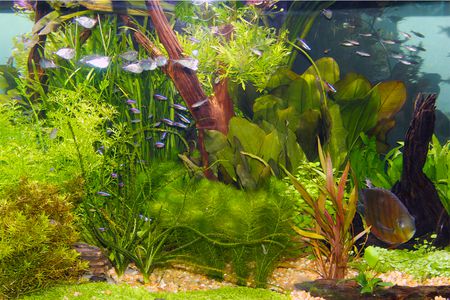How Java Fern Can Improve Water Quality and Provide Natural Filtration
Java Fern Microsorum pteropus is a popular aquatic plant in the aquarium hobby due to its adaptability, aesthetic appeal, and beneficial effects on water quality. Native to Southeast Asia, Java Fern is not only an attractive addition to aquatic setups but also plays a crucial role in natural filtration. Here is how Java Fern can improve water quality and provide natural filtration in your aquarium. Java Fern contributes to water quality through its unique growth habits and interactions with the aquarium environment. Java Fern attaches itself to surfaces like rocks, driftwood, or aquarium decorations using its rhizomes. This characteristic allows it to thrive in various aquarium setups, from low-tech tanks to advanced systems.
Nutrient Absorption – Java Fern effectively absorbs excess nutrients from the water, particularly nitrogenous compounds such as ammonia, nitrites, and nitrates. These nutrients are often byproducts of fish waste, uneaten food, and decaying organic matter. By removing these compounds from the water column, micro java fern helps maintain a balanced nutrient level, reducing the risk of algae overgrowth and promoting a healthier aquatic environment.

Oxygenation – Like other aquatic plants, Java Fern undergoes photosynthesis, a process that converts carbon dioxide CO2 into oxygen. During the day, Java Fern absorbs CO2 from the water and releases oxygen as a byproduct. This oxygenation improves overall water quality, benefiting fish and other aquatic organisms by enhancing respiration and promoting a more stable and healthy ecosystem.
Biofilm Formation – The surfaces of Java Fern, including its fronds and rhizomes, can become covered in beneficial microorganisms and biofilms. These biofilms consist of bacteria and other microorganisms that contribute to the biological filtration process. They help break down organic matter and convert harmful substances into less toxic forms, further improving water quality.
Algae Suppression – By competing for nutrients and light, Java Fern can help suppress algae growth. Algae often thrive in environments with high nutrient levels and excess light. Java Fern’s ability to absorb nutrients reduces the availability of resources for algae, thereby limiting their growth and helping maintain a clearer, more aesthetically pleasing aquarium.
To maximize the benefits of Java Fern in your aquarium, consider the following tips for setting it up and maintaining its health:
Attachment – Secure Java Fern to rocks, driftwood, or other aquarium decorations using thread, fishing line, or aquarium-safe glue. Avoid planting it in substrate, as it can lead to rot if the rhizome is buried.
Lighting – Java Fern thrives under low to moderate lighting conditions. Excessive light can lead to algae growth on its leaves, so it is essential to provide balanced lighting that meets the plant’s needs without promoting unwanted algae.
Water Conditions – Java Fern is adaptable to various water conditions, but it prefers slightly acidic to neutral pH levels 6.0–7.5 and a temperature range of 22–28°C 72–82°F. Regular water changes and maintaining stable parameters will support its health and effectiveness in filtration.
The needle leaf java fern is more than just a decorative element in the aquarium. Its natural filtration abilities, through nutrient absorption, oxygenation, biofilm formation, and algae suppression, make it a valuable addition to any aquatic setup. By incorporating Java Fern into your tank, you not only enhance its visual appeal but also contribute to a healthier, more balanced aquatic environment.